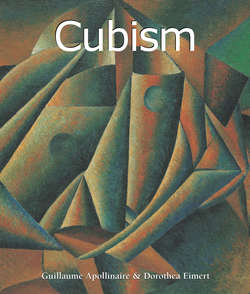Читать книгу Cubism - Guillaume Apollinaire - Страница 5
На сайте Литреса книга снята с продажи.
II. What Is Cubism?
Picasso, Braque and the “Popular” Image
ОглавлениеGeorges Braque and Pablo Picasso invented a new type of painting, expressing daily life in the form of real materials. For this, they used fabrics, wax cloth, wallpaper scraps and newspaper shreds, using these items to create fine art. This was the birth of their so-called papiers collés. The interest of Picasso in the tactile and in unusual materials found its first visual realisation in May 1912 with his piece entitled Still Life with Chair Caning. This painting showcases Picasso’s use of common materials in an unorthodox manner. The printed pattern on the wax cloth conveyed the illusion of chair caning. The pasted paper appears to be something else than what it truly is, while the rope framing it is a tangible object. Shortly thereafter, Braque found a roll of wallpaper with an oak pattern, which he then cut into pieces and integrated them into a drawing. These endeavours eventually led to pure surface textures being contrasted against one another and forming a coherent artwork.
Braque and Picasso considered their studio to be a place completely devoted to craftsmanship. Using everyday materials, they experimented with extending art into the realm of the ordinary. In 1912 and 1913, they chose paper as their primary medium. In order to develop their idea of a “popular iconography”, they used cardboard, paper of many shades and patterns, sand, combs, sawdust, metal shavings, ripolin varnish, sheet metal stencils, razor blades and craft tools. Apollinaire and André Salmon compared the efforts of Braque and Picasso with those of the poet François de Malherbe; the painters sought readily comprehensible simplicity, just as the poet had studied the slang spoken by the dock workers in order to enrich his own language.
The papiers collés were preceded by paper sculptures, first by Braque and later on by Picasso. Already by 1911, Braque had created his first paper sculpture. Picasso, when viewing the construction scaffolding of these first Braque paper sculptures, was reminded of the Wright brothers’ biplane.
Of all the artists of the 20th century, Pablo Picasso was a true genius. Like no other artist, he made important contributions and innovations to nearly all of the artistic movements of the 20th century. He journeyed to unexplored shores in the sea of the art world, and repeatedly produced surprising new masterpieces.
Pablo Picasso, The Pont-Neuf, 1911.
Oil on canvas, 33 × 24 cm.
Private collection.
Pablo Picasso, Girl with a Mandolin (Fanny Tellier), 1910.
Oil on canvas, 100.3 × 73.6 cm.
The Museum of Modern Art, New York.
Georges Braque, Woman with a Guitar, 1913.
Oil and charcoal on canvas, 130 × 73 cm.
Musée National d’Art Moderne, Centre Georges-Pompidou, Paris.
